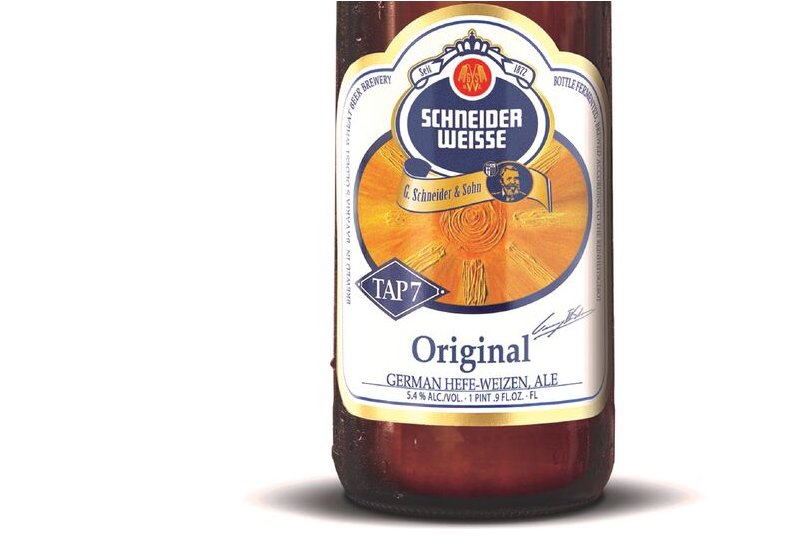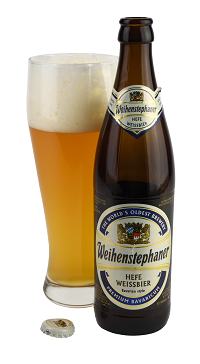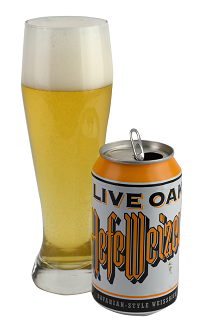Schneider Weisse: Wheat Beer’s Last Stand

(Photo courtesy G. Schneider & Sohn)
The village of Kelheim, smack dab in the center of Bavaria, does not appear to be hallowed ground. It has the same tidy, charming appearance of so many little towns that dot the Bavarian countryside. True, there’s a larger-than-average brewery just to the east of the town square and, true, it does announce itself as a maker of wheat ales—unexpected in lager country. But wheat beer (known variously as weizen or weissbier) is available at every beer hall in Bavaria; surely this isn’t that special?
To the contrary; G. Schneider & Sohn is where wheat beer made its last stand, and the flagship brewed there, Schneider Weisse, is one of the most interesting and important beers still made in the world.
The history, the style, and the beer are so interesting, in fact, one hardly knows where to begin. Maybe a little history first. One of the oldest extant beer types, weizens probably date to the 1400s and got their start in neighboring Bohemia. They took decades to creep westward, and when they finally did, around 1500, found it difficult to cross the border. A Bavarian law, Reinheitsgebot, specified that beer could only be made of malted barley. As a result, for most of the next four centuries, the state had to specially authorize breweries to make wheat beer.
Weissbier’s heyday lasted for centuries, but it went into steep decline in the 1800s, when just two breweries were making it. In the 1850s, a brewer name Georg Schneider managed to acquire a lease on a wheat brewery in Munich and, wanting to improve weissbier’s fortunes, he pushed for a change in the law so that anyone could make it. Although he was successful, it took another century before weizen started to rebound in popularity—as late as 1960, it accounted for only 3 percentof Bavaria’s production (it is today one of the two most popular styles). Without the Schneider family’s patronage, this old style would almost certainly have gone extinct.
But if the history is striking, the beer is even more so. Bavarian weizens have become so accepted that we forget how truly weird they are. The wheat itself is uncommon, but add to that the milkshake appearance and the flavors of banana and clove and you have something wholly unique. Each of those characteristics emerges from process more than ingredient—which takes us back to that 410-year-old brewery in Kelheim.
What characterizes a wheat beer brewery? Things look pretty normal in the brewhouse, where the beer goes through a standard, if more complex mashing, followed by routine boiling. All the curious business begins after the chilled wort enters the fermenters. Weizens are yeast-driven beers, and to get the most from the biochemistry, traditional breweries use open-fermentation. Schneider’s fermentation room is as big as a basketball court, and vast fermenters bubble and burp like witches’ cauldrons. When I toured the brewery with longtime master brewer Hans-Peter Drexler, he visibly flinched when we entered. We were vectors for wild yeast and bacteria, and everything in his fiber told him this was unsafe. “These open fermenters are very hard to control,” he told me. “The biggest challenge in the brewery is to keep the biological balance in the right way.”
Open fermentation is important for developing those wonderful esters of banana and fruit; yeast confined to closed, upright fermenters will produce substantially fewer esters, particularly isoamyl acetate, responsible for the banana. Fermentation is also when the clove flavors are developed. It’s a process that begins during mashing, when ferulic acid is released from barley at certain temperatures. When a certain kind of yeast strain encounters ferulic acid, it converts it into 4-vinyl guaiacol, the phenol responsible for the clove flavor. Breweries control the levels of fruit and spice in their wheat beers by manipulating fermentation, not by adding different ingredients.
Schneider Weisse, despite its historic status, is an unusual weizen. Unlike most straw-colored weissbiers, Schneider’s is deeper, heading almost toward chestnut.
Some breweries tend to favor banana, but Schneider highlights spice, with a clove note that has hints of nutmeg and pepper. The banana is subdued and other fruity esters join it—tropical fruit and citrus. “For me, there are different styles of aroma in a Bavarian wheat beer,” Drexler explained. “Most of them are very fruity; there’s one that is more neutral. And there are some that are more spicy like the Schneider yeast.”
Following fermentation, beer would typically go to a conditioning tank to clarify. But, since weissbier is designed to be cloudy, Drexler instead doses it with speise, or wort (“food” in German), and puts it directly into the bottle. Until the mid-2000s, when Schneider began making kristalweizen, a haze-free wheat beer, they didn’t even own conditioning tanks. The speise gives all that yeast something to chew on, and the result is the hugely effervescent beer you pour from a bottle of Schneider.
Now scores of Bavarian breweries make weissbier, and thousands more outside Germany. Very few do it in a brewery designed for making wheat beers, and no one has done it longer. “It’s the same system as a hundred years before,” Drexler told me. “The only difference is a hundred years ago they had wooden vessels and we have stainless steel.” Age and tradition don’t guarantee quality, but Schneider Weisse remains the gold standard.
Jeff Alworth is the author of The Secrets of Master Brewers and The Beer Bible.

Weihenstephaner Hefe-Weissbier
ABV: 5.4% | Bavarian Wheat BeerTasting Notes: The bouquet from Weihenstephaner is all banana and bubble gum and represents a competing model for weissbier. High carbonation creates a sense of rich creaminess, and the sweet fruitiness turns Weihenstephan into a confection. There are phenols here, but you have to pay close attention to find them.

Sierra Nevada Kellerweis
ABV: 4.8% | Bavarian-Style Wheat BeerTasting Notes: Sierra Nevada's offering is an unusual weizen, beginning with lower levels of effervescence. The nose, smoke and sagebrush, confirms matters. But the differences are beguiling, as the smoke develops into tanginess, with just hints of clove. The esters are light banana and white wine, leaving crevices in the palate for crackerlike wheat to peek through.

Live Oak Hefeweizen
ABV: 5.3% | Bavarian-Style Wheat BeerTasting Notes: There's something Texan about the flavors of Live Oak, one of the best weissbiers around. They're big, with booming spiciness that begins as clove and evolves into something like witch hazel and mint. The banana esters play a supporting role, filling in the spaces left by spiky phenols with gentle sweetness.

Schneider Weisse is a true gem and one the of the world’s truly exceptional beers. It would be easy to rest on their laurels with such great beer as the Tap 7 Original and Tap 6 Aventinus, but Schneider continues to bring interesting new beer out on the market – it’s Tap 5 Hopfenweisse and the constantly changing Tap X. Visiting Bavaria requires a visit to Schneider – whether in Kelheim or in Tal 7 in downtown Munich – don’t miss it!
Not being an expert, just a beer lover and a frequent visitor to Bavaria, my preference for Weißbier is Erdinger, particularly for breakfast.
Weißbier, Weißwurst, Süßer Senf(sweet mustard), bretzen(bread shaped like a pretzel) und(and) alte Freunde(old friends) is the best breakfast ever.
Is Schneider Weisse available in the USA?
Absolutely! And give their Aventinus a try too — it’s a more robust wheat beer called a weizenbock.
I’ve never seen Schneider-Weisse in the U.S. I’m close to an Alcohol store that has Paulaner and Weihenstephaner though and I’ve tried both those styles of Weizen and I found Paulaner to be enjoyable and kind of complex in flavor. I hope I can try Schneider-Weisse one day as well.